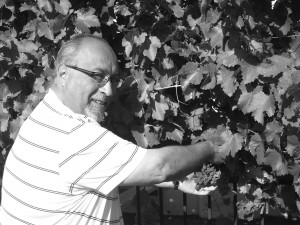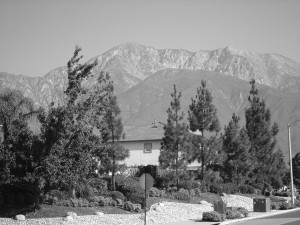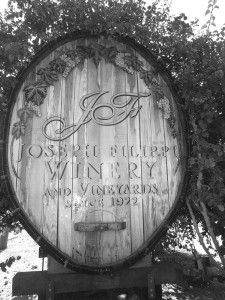 by Domenico Cellucci
by Domenico Cellucci
Some of my previous articles have highlighted the role Italian immigrants have played in the development of wine making in the “Golden State” as California is known. When you mention California wine, wine lovers often think of Napa and Sonoma. And rightly so, since these 2 viticultural areas produce some of the best wine not only in California, but in the world. Historically however, it was Southern California and more specifically, Los Angeles County and environs that were initially responsible for the first plantings of European grape vines.
Recently, I visited the city of Rancho Cucamonga, a small city, with a population of 165 000 in San Bernardino county. It is located just 63 km east of Los Angeles. It sits at the base of the beautiful San Gabriel Mountains. The city derives its name from the Kucamongan Indian tribe, who established a village here around 1200 AD. In 1769, Spanish Captain Gaspar de Portola along with Franciscan monks began to colonize the territory known as Baja California. The Monks established Missions, which are a system of Ranches primarily for the production of cattle. It was at the Missions that the first wines were produced for sacramental purposes. Many believe the mission grape, (which many of our dads use for home winemaking), derives its name from these Missions.
 Once Mexico was granted independence from Spain, the area then called Cucamonga, was granted to a Mexican soldier by the name of Tapia, who raised cattle and began a winery. The area was annexed by the United States in 1848. By the 1850’s there were more than 100 wineries in the Los Angeles area. At the time, Los Angeles had a population of only 2000 people! Much of the wine produced there was shipped north to the San Francisco area during the Gold Rush. By 1869, the Los Angeles area produced 4 million gallons of wine, making it, the leading producer in all of California. The arrival of the Union Pacific Railroad in 1887 brought many Italian immigrants to the area from the east coast.
Once Mexico was granted independence from Spain, the area then called Cucamonga, was granted to a Mexican soldier by the name of Tapia, who raised cattle and began a winery. The area was annexed by the United States in 1848. By the 1850’s there were more than 100 wineries in the Los Angeles area. At the time, Los Angeles had a population of only 2000 people! Much of the wine produced there was shipped north to the San Francisco area during the Gold Rush. By 1869, the Los Angeles area produced 4 million gallons of wine, making it, the leading producer in all of California. The arrival of the Union Pacific Railroad in 1887 brought many Italian immigrants to the area from the east coast.
In 1883, Pierce’s Disease, struck the vineyards in the Los Angeles area. This disease is a bacterial infection that is spread by a bug known as the sharpshooter. It virtually destroyed winemaking in the Los Angeles area. Many vineyards were uprooted and oranges groves were planted in their place. In 1889, a new county in fact was carved out of Los Angeles County: “Orange County”. Another threat to vineyards, phylloxera, destroyed vineyards planted with European vines, in Europe and the US around this time as well. In this case, a pest, known as an aphid, chews on the roots, slowly killing the vines. The Cucamonga area was spared as the soils are sandy and not attractive to the aphid.

Italian immigrant, Secondo Guasti arrived from Italy in 1878. He established a boarding house and restaurant. In 1883, he founded the Italian Vineyard Company. He sold shares in the company and financed other vineyards in the Los Angeles area. By 1900 he had planted 5000 acres of vines. It was called the “largest vineyard in the world” at the time. Many followed with their own vineyards and by prohibition, 200 000 a
cres were planted with vines. During prohibition, home winemaking (which was permitted) across the United States kept wineries in business till its repeal in 1936. Before the beginning of the Second World War, southern California produced 12 million gallons of wine and had over 160 wineries. Grapes continued to be shipped east and around the country to home winemakers.
The post-war years in San Bernardino County saw agricultural land being eliminated by the construction of homes and businesses. In the 1950’s, the number of wineries dropped to 68. Acreage devoted to grapes dropped from 23000 in 1960 to 100 in 1997. The 1970’s saw urban sprawl from nearby Los Angeles and Orange county flow into Rancho Cucamonga. Today, the city is successful with beautiful suburban neighbourhoods, industrial and business parks. In 2006, Money Magazine, ranked Rancho Cucamonga 42nd, as one of the best places to live in the United States. However, it has come at the cost of agricultural land.
Today, only a few wineries remain enveloped by the city. San Antonio Winery was founded in 1917 by Santo Cambianica. His nephew Stefano Riboli took over in 1956. Today it boasts a restaurant plus storefronts in Ontario, California and Paso Robles. You also have Galleano Winery which first began growing grapes in 1927. The founder Don Galleano saved grape vines in Rancho Cucamonga that were more than 100 years old. In fact some of the oldest vines in California are in Rancho Cucamonga.
I visited J. Fillippi Winery. It first began growing grapes in 1922. Today 5th generation winemaker, Jared Fillippi continues the winemaking traditions of his family. Over 40 different types of wines are produced, including whites, reds, rosés, sparkling, non-alcoholic sparkling, fortified and even a ginseng/cabernet/merlot blend! Wines made with Italian varietals are Sangiovese and Pinot Grigio. The winery and the vineyard are completely surrounded by the city of Rancho Cucamonga. I focused my eyes on the vineyard and the beautiful San Gabriel Mountains. It makes you wonder how beautiful the area must have been at the end of the 19th century when the first Italians began to arrive…..
Grazie e salute!
If you have any questions or suggestions for future columns, please contact me at vinumbonumest@yahoo.com. Domenico Cellucci is a wine consultant and educator and is a graduate of Algonquin College’s Sommelier Program. He puts on food and wine matching events in the national capital area. He has visited wineries and vineyards in Italy, France, British Columbia, Ontario and the United States.